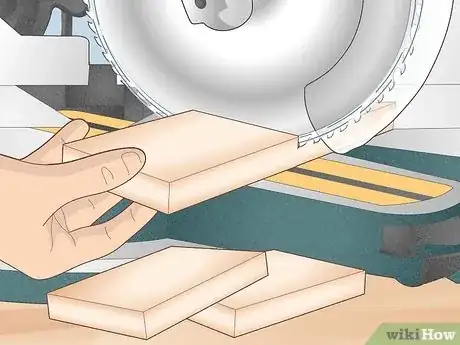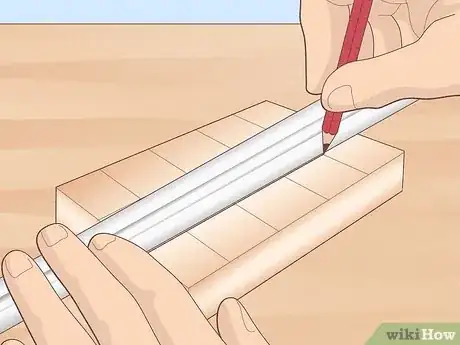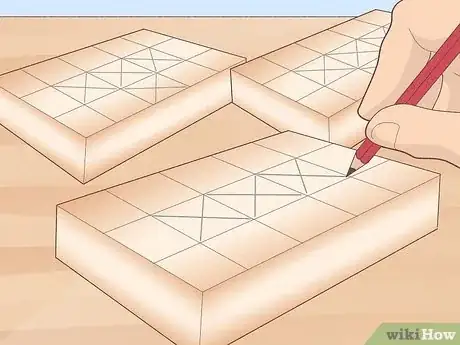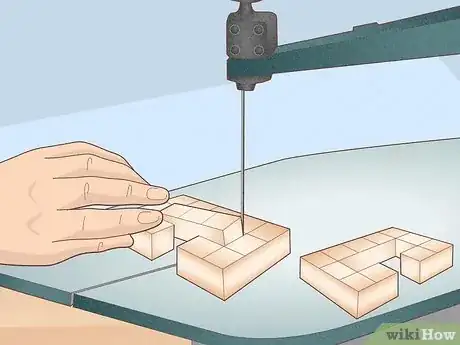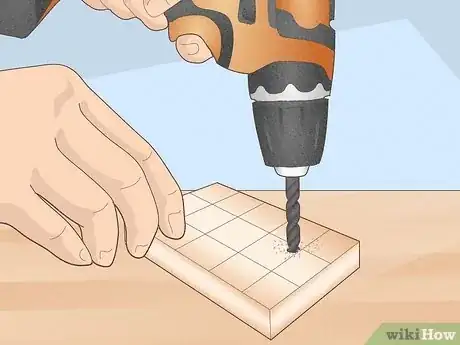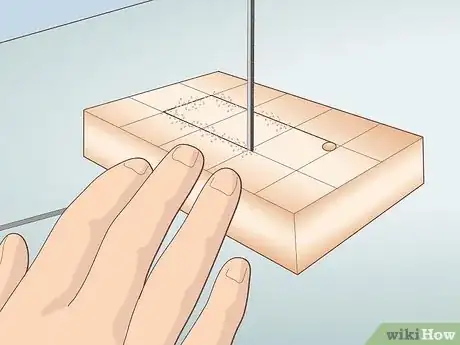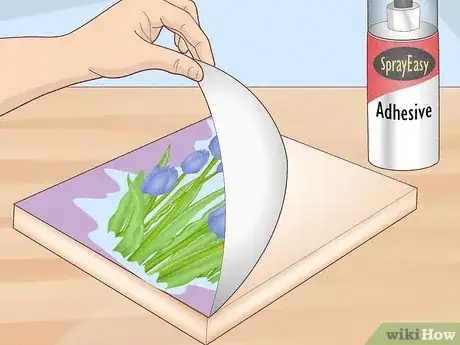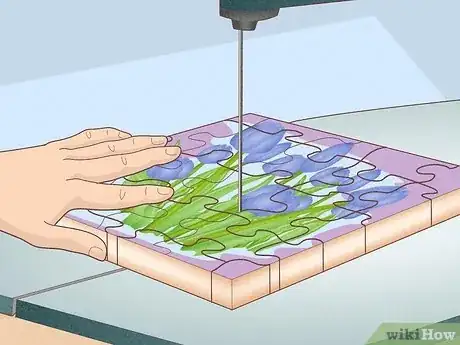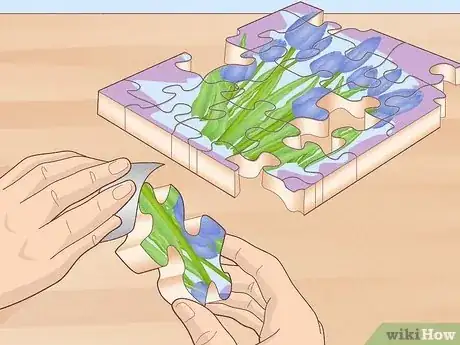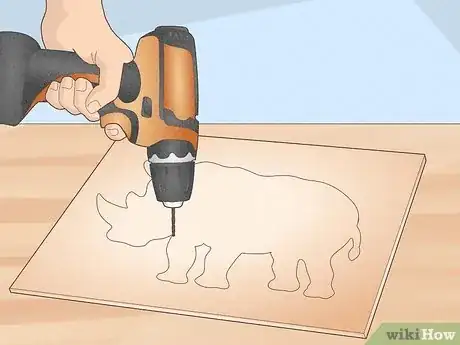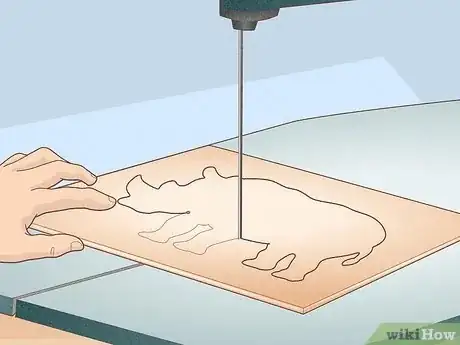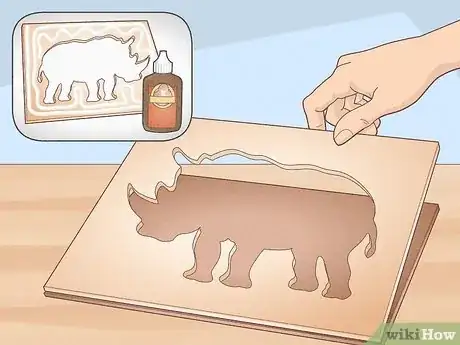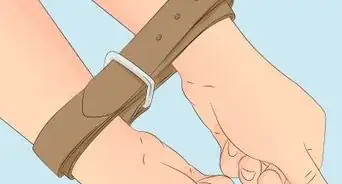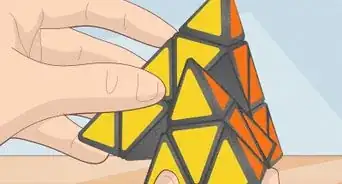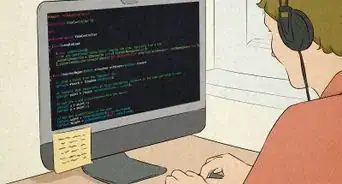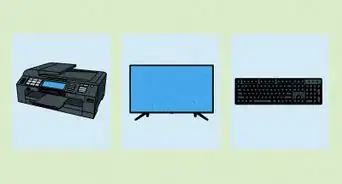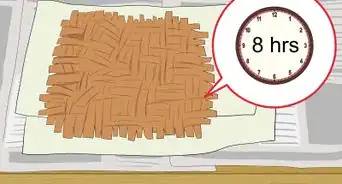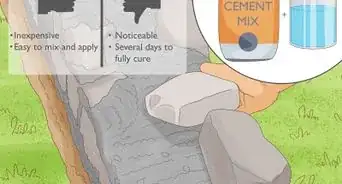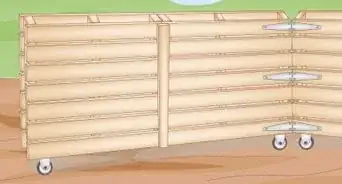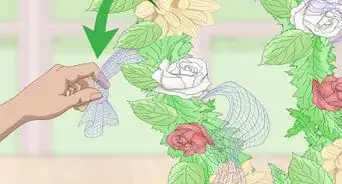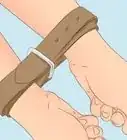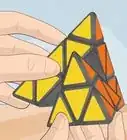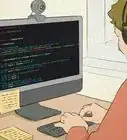This article was co-authored by wikiHow staff writer, Hunter Rising. Hunter Rising is a wikiHow Staff Writer based in Los Angeles. He has more than three years of experience writing for and working with wikiHow. Hunter holds a BFA in Entertainment Design from the University of Wisconsin - Stout and a Minor in English Writing.
There are 23 references cited in this article, which can be found at the bottom of the page.
This article has been viewed 8,138 times.
Learn more...
Are you looking for a fun DIY toy that you can make at home with some scrap wood? Wooden puzzles are a challenge when you’re putting them together, but they’re easy to design on your own with a few tools. Whether you want to make an interlocking wood puzzle that teases your brain or a simple jigsaw puzzle for kids, we’ve got you covered. Just keep reading to learn how you can create a wooden puzzle from scratch!
Steps
3D Interlocking Block Puzzle
-
1Saw a board into 3 rectangular pieces. Get a 13 × 2 1⁄4 × 3⁄4 in (33.0 × 5.7 × 1.9 cm) board of hardwood, such as maple, poplar, or birch.[1] Mark 3 3⁄4 in (9.5 cm) lengths on the board, leaving about 1⁄4 inch (0.64 cm) between the pieces so you can make clean cuts. Use a miter saw to make straight cuts through your lines so you have 3 pieces of wood that are the same size.[2]
- A miter saw has a large circular blade to ensure that you can make long, straight cuts.
- Alternative: If you don’t have a saw at home, ask to have your wood cut at the store when you buy your supplies.
- Put on safety glasses before you use any power tools to protect your eyes from dust and wood chips.
-
2Draw a 3 x 5 grid on the fronts of the wood pieces. Measure every 3⁄4 inch (1.9 cm) along the edges of the wood pieces and mark them with a pencil. Draw straight lines across the front of the wood to create a 3 x 5 grid of squares on each piece.[3]
- Make the lines lightly so you don’t leave any indentations in the wood and can easily erase your marks.
Advertisement -
3Mark the 3 or 4 center squares on each wood piece with a pencil. On each of the wood pieces, draw a large X inside the 3 squares in the center that don’t touch an edge. Then, for 2 of the pieces, mark the 3rd square along one of the long edges so the unmarked squares look like the letter C.[4]
- Marking the squares helps you see which ones you need to cut out at a glance so you don’t make a mistake.
-
4Saw 2 of the wooden pieces into C-shapes with a scroll saw. Put on your safety glasses and use a #7 blade on a scroll saw to cut through the wood. Turn on the scroll saw and slowly push the wood into the blade to make your cuts. Follow along the outlines of the marked squares to cut them out completely.[5]
- Scroll saws have narrow blades so you’re able to cut out curves and more intricate pieces without damaging the saw.
- Alternative: If you don’t have a scroll saw, you may be able to carefully cut out the pieces with a hacksaw instead.
- Try cutting the squares out in multiple pieces if you have trouble trying to remove them as a single piece.
- Be careful not to push the wood with a lot of force since you could damage the saw blade or get injured.
-
5Drill through the middle square on the last wood piece. Use a drill bit that’s slightly wider in diameter than your scroll saw’s blade. Take the last uncut wood piece, and position the drill right next to the outline on the middle square. Apply light pressure to guide the bit through the wood.[6]
- Drilling the hole in the last wood piece lets you saw the squares without cutting a line in from the edge.
- Forcing the bit through the wood could damage the drill or the wood, so work slowly if you feel resistance.
-
6Cut out the 3 central squares to make an O-shaped piece. Put your scroll saw’s blade through the hole you just drilled in the wood piece. Turn on your saw and slowly guide the wood through the blade. Carefully follow along the outlines of the 3 middle squares to remove them from the wood piece.[7]
- Keep your fingers to the side of the saw blade as you guide the wood so there’s less risk of cutting yourself.[8]
-
7Smooth out the cut edges with sandpaper. You can use any grit sandpaper that you have to smooth out your puzzle. Fold the sandpaper a few times and gently rub the sides of the wood pieces that you cut. As you sand, try sliding one of the pieces through the middle hole of another piece to test if they move smoothly or still catch on the wood.[9]
- You can also sand over the grid lines that you drew to remove them instead of using an eraser.
Wooden Jigsaw Puzzle
-
1Stick a photo on a piece of plywood with spray adhesive. Lay an 8 in × 10 in (20 cm × 25 cm) photo upside-down next to a 3⁄4 in (1.9 cm) piece of plywood with the same dimensions. Hold a can of spray adhesive a few inches above your photo and spray an even layer on the back of the photo and the plywood surface. After about 30 seconds, press the picture onto the plywood.[10]
- You can use any photograph or print a picture off on a sheet of paper to use for your puzzle.
- Set your picture and plywood on a scrap piece of cardboard to protect the surface underneath from the spray adhesive.
-
2Draw the shapes of the puzzle pieces onto the picture. Lightly sketch in where you want the pieces with a pencil so you know where to make your cuts. Give each piece a random shape that has at least 1 knob-shape jutting in or out from a side so the pieces interlock. Once you’re happy with the outlines of your pieces, you can move on.[11]
- If you don’t want to draw your own puzzle pieces, print off an 8 in × 10 in (20 cm × 25 cm) puzzle template and tape it over the picture.
-
3Cut the pieces out with a scroll saw. Put on a pair of safety glasses before you start working to protect your eyes. Start your scroll saw and slowly push the wood through the blade to follow the outlines of the pieces. Turn the wood to follow along with any curves as you cut out each of the individual pieces.[12]
- Try not to rush through cutting the pieces since you could easily make a mistake or damage the saw.
-
4Sand the cut edges so they easily fit together. You can use any grit sandpaper to finish up your puzzle. Gently rub the cut sides of the pieces to smooth out any fuzzy or rough edges left from the saw. As you sand, try to fit the pieces together to make sure that they slide together smoothly without resistance.[13]
- Be careful not to over-sand the puzzle pieces since it could prevent them from interlocking or having a tight fit.
-
5Apply spray lacquer to the pieces if you want to keep them protected. Use a clear coat spray lacquer as a finish for your puzzle. Give the can a few shakes and hold it a couple of inches above your puzzle. Spray the lacquer vertically in a thin coat over the fronts of the puzzle pieces and let it dry. Then, apply a second thin coat spraying the pieces horizontally.[14]
- Work outside or in a well-ventilated area to protect yourself from fumes.
Wooden Tray Puzzle
-
1Draw or glue the outline of the puzzle onto a piece of plywood. Use a 8 × 10 × 1⁄8 in (20.32 × 25.40 × 0.32 cm) piece of plywood to start your puzzle. Use a pencil to free-hand the design that you want for the main shape of your puzzle. If you don’t want to draw your design, print out an outline that fits on your plywood and use a spray adhesive to stick it on.[15]
- Make sure the outline doesn’t touch or extend past the edge of the plywood.
- You don’t need to draw the individual puzzle pieces just yet.
-
2Drill a hole through the plywood next to the inside of your outline. Use a drill bit that’s slightly wider than the saw blade you plan on using. Position the tip of your drill on the inside of the outline as close to the design as you can so it’s easier to start your cut. Put on safety glasses and slowly drill straight through the plywood.[16]
- Making a hole in the plywood gives you a place to start cutting with your saw so you don’t have to cut in from one of the edges.
-
3Cut the shape out of the plywood with a scroll saw. Guide the blade of your scroll saw through the hole you just drilled in your plywood. Put on your safety glasses before you start the saw and slowly guide the wood through the blade. Follow along the inside of your outline as closely as you can as you cut the entire shape out.[17]
- Avoid putting your fingers directly in front of the saw blade. Keep your hands out to the sides as you guide the wood instead.[18]
-
4Smooth the cut edges with sandpaper. Stick with 240-grit sandpaper since it will give you the smoothest finish. Gently rub the edges of the shape you just cut out to get rid of any rough or fuzzy edges. Then, smooth out the cut edges on the piece of plywood as well. Set the cutout shape into the hole in the plywood, and sand it more if it doesn’t easily fit or slide in.[19]
- If you glued a design to the plywood to follow, rub the paper with your sandpaper to remove it.
-
5Glue the piece of plywood onto a piece of MDF. Flip over the piece of plywood that you made a cutout from and apply a thin layer of wood glue over the surface. Set the plywood on top of an 8 × 10 × 1⁄8 in (20.32 × 25.40 × 0.32 cm) piece of MDF so the edges are flush. Use C-clamps to hold the plywood and MDF together until the pieces are dry, which will take about a day.[20]
- The MDF acts as the bottom of the tray so you slot the puzzle pieces into the cutout without them falling out.
-
6Draw and cut out puzzle pieces from the shape you cut out. While the plywood and MDF are drying, use a pencil to lightly sketch in where you want the puzzle pieces on your cut-out design. You can draw the pieces as large or as small as you want. Try to give each piece a knob-shape extending out from one side so the pieces interlock.[21] Put on your safety glasses before turning on your scroll saw, and carefully push the wood through the blade to follow along with the outlines of the puzzle pieces.[22]
- Since tray puzzles are usually simpler and meant for toddlers, opt for fewer larger pieces so the puzzle is easier to complete.
-
7Sand the edges of the puzzle pieces. Use your 240-grit sandpaper to smooth out the edges you just got on the pieces. As you’re sanding, slot the pieces into the tray to make sure they fit together without any resistance.[23]
- If you have trouble putting the pieces together, it’s a good sign that you should sand them a little bit more.
-
8Paint your puzzle pieces if you want to add a fun design. You can use acrylic paint or spray paint to decorate the pieces. Apply a thin coat of paint onto the surface of the wood and let it dry completely before you add a second coat. After you finish painting, your puzzle is all finished![24]
- You can also paint the bottom of the tray the same colors as the puzzle pieces to make it easier for kids to find where they fit in.
Things You’ll Need
3D Interlocking Block Puzzle
- 13 × 2 1⁄4 × 3⁄4 in (33.0 × 5.7 × 1.9 cm) board
- Ruler
- Pencil
- Safety glasses
- Miter saw
- Drill
- Scroll saw
- Sandpaper
Wooden Jigsaw Puzzle
- 8 × 10 × 3⁄4 in (20.3 × 25.4 × 1.9 cm) plywood
- 8 in × 10 in (20 cm × 25 cm) photo print
- Spray adhesive
- Pencil
- Safety glasses
- Scroll saw
- Sandpaper
- Spray lacquer (optional)
Wooden Tray Puzzle
- 8 × 10 × 1⁄8 in (20.32 × 25.40 × 0.32 cm) plywood
- 8 × 10 × 1⁄8 in (20.32 × 25.40 × 0.32 cm) piece of MDF
- Safety glasses
- Drill
- Scroll saw
- 240-grit sandpaper
- Wood glue
- C-clamps
- Paint (optional)
References
- ↑ https://www.bobvila.com/articles/types-of-wood/
- ↑ https://youtu.be/bogXj4dQTYQ?t=46
- ↑ https://youtu.be/bogXj4dQTYQ?t=21
- ↑ https://youtu.be/bogXj4dQTYQ?t=36
- ↑ https://www.craftsmanspace.com/sites/default/files/free-plans-pdf-files/Knot%20Burr%20Puzzle.pdf
- ↑ https://youtu.be/bogXj4dQTYQ?t=58
- ↑ https://youtu.be/bogXj4dQTYQ?t=105
- ↑ https://ucanr.edu/sites/safety/files/66216.pdf
- ↑ https://www.craftsmanspace.com/sites/default/files/free-plans-pdf-files/Knot%20Burr%20Puzzle.pdf
- ↑ https://youtu.be/FeDnFd0e8H0?t=60
- ↑ https://youtu.be/FeDnFd0e8H0?t=99
- ↑ https://youtu.be/CgvYeSEaaLA?t=531
- ↑ https://youtu.be/FeDnFd0e8H0?t=151
- ↑ https://youtu.be/CgvYeSEaaLA?t=687
- ↑ https://youtu.be/nwMCH3-28FI?t=40
- ↑ https://youtu.be/nwMCH3-28FI?t=51
- ↑ https://youtu.be/o46I4VU8IRc?t=151
- ↑ https://ucanr.edu/sites/safety/files/66216.pdf
- ↑ https://youtu.be/nwMCH3-28FI?t=94
- ↑ https://youtu.be/nwMCH3-28FI?t=98
- ↑ https://youtu.be/nwMCH3-28FI?t=140
- ↑ https://youtu.be/Xb6Dm9Zj5Sw?t=30
- ↑ https://youtu.be/nwMCH3-28FI?t=159
- ↑ https://youtu.be/o46I4VU8IRc?t=215
- ↑ https://www.powertoolinstitute.com/pti_pdfs/PTI_Safety_general_safety.pdf
